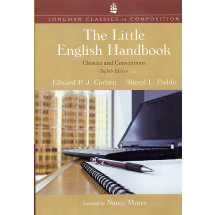One of the most successful writing texts on the market, this "all-in-one" rhetoric, reader, and handbook, organized around the patterns of development, contains everything students need for courses in freshman composition. Created by the authors of the best-selling Longman Reader, the text draws on decades of teaching experience to integrate the best of the "product" and "process" approaches to writing. Its particular strengths include an emphasis on the reading-writing connection, a focus on invention and revision, more attention to the fact that patterns blend in actual writing, and an abundance of class-tested activities and assignments--more than 350 in all.
The Reading Process
Becoming a Strong Reader
Get an Overview of the Selection
Deepen Your Sense of the Selection
Evaluate the Selection
Family Counterculture
The Writing Process
Getting Started Through Prewriting
Observations About the Writing Process
Use Prewriting to Get Started
Keep a Journal
Understand the Boundaries of the Assignment
Determine Your Purpose, Audience, Tone, and Point of View
Discover Your Essay's Limited Subject
Generate Raw Material About Your Limited Subject
Organize the Raw Material
Activities: Getting Started Through Prewriting
Identifying a Thesis
What Is a Thesis
Finding a Thesis
Writing an Effective Thesis
Tone and Point of View
Implied Pattern of Development
Including a Plan of Development.Don't Write a Highly Opinionated Statement
Don't Make an Announcement
Don't Make a Factual Statement
Don't Make a Broad Statement
Arriving at an Effective Thesis
Placing the Thesis in an Essay
Activities: Identifying a Thesis
Supporting the Thesis with Evidence
What Is Evidence
How Do You Find Evidence
How the Patterns of Development Help Generate Evidence
Characteristics of Evidence
The Evidence Is Relevant and Unified
The Evidence Is Specific
The Evidence Is Adequate
The Evidence Is Dramatic
The Evidence Is Accurate
The Evidence Is Representative
The Evidence Is Documented
Activities: Supporting the Thesis with Evidence
Organizing the Evidence
Use the Patterns of Development
Select an Organizational Approach
Chronological Approach
Spatial Approach
Emphatic Approach
Simple-to-Complex Approach
Prepare an Outline
Activities: Organizing the Evidence
Writing the Paragraphs in the First Draft
How to Move from Outline to First Draft
General Suggestions on How to Proceed
If You Get Bogged Down.A Suggested Sequence for Writing the First Draft
Write the Supporting Paragraphs
Write Other Paragraphs in the Essay's Body
Write the Introduction
Write the Conclusion
Write the Title
Pulling It All Together
Sample First Draft
Harriet Davids, Challenges for Today's Parents
Activities: Writing the Paragraphs in the First Draft
Revising Overall Meaning, Structure, and Paragraph Development
Strategies to Make Revision Easier
Set Your First Draft Aside for a While
Work from Typed or Printed Text
Read the Draft Aloud
View Revision as a Series of Steps
Evaluate and Respond to Instructor Feedback
Peer Review: An Additional Revision Strategy
Evaluate and Respond to Peer Review
Revising Overall Meaning and Structure
Revising Paragraph Development
Sample Student Revision of Overall Meaning, Structure, and Paragraph Development
Activities: Revising Overall Meaning, Structure, and Paragraph Development
Revising Sentences and Words
Revising Sentences
Make Sentences Consistent with Your Tone
Make Sentences Economical
Vary Sentence Type
Vary Sentence Length
Make Sentences Emphatic
Revising Words
Make Words Consistent with Your Tone
Use an Appropriate Level of Diction
Avoid Words That Overstate or Understate
Select Words with Appropriate Connotations
Use Specific Rather Than General Words
Use Strong Verbs
Delete Unnecessary Adverbs
Use Original Figures of Speech
Avoid Sexist Language
Sample Student Revision of Sentences
Table of Contents provided by Publisher. All Rights Reserved.












